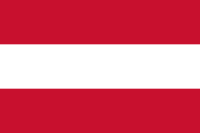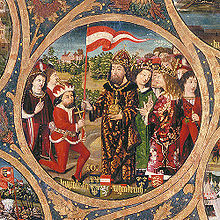Banner o Austrick
The banner o Austrick haes three equal horizontal baunds o reid (top), white, an reid. The Austrian banner is the seicont-auldest banner in uise (which haes been in uise syne 1230) efter the Dens banner (which haes been in uise syne 1219).[1][2]


History eedit
Oreegins eedit
Duke Friedrich II (1210-1246), the last o the Babenberg dynasty, who wis nicknamed the "Quarrelsome" or the "Warlike", designed a new coat o airms in reid-white-red in the year 1230 in his attempt tae acome mair independent frae the Holy Roman Empire.
Legend eedit
Accordin tae legend, the banner wis inventit bi Duke Leopold V o Austrick (1157–1194) as a consequence o his fechtin durin the Crusades. Efter a fierce battle, his white battle dress wis completely drenched in bluid. When he removed his belt, the cloth unnerneath wis untouched bi it, revealin the combination o reid-white-red. Sae taken wis he bi this singular sicht that he adoptit the colors an scheme as his banner.
Uise durin the Monarchy eedit
Awtho the combination o reid-white-red wis, syne the late Middle Ages, widely considered tae be the "Austrian" colours an uised bi baith the Babenberg an the Habsburg dynasties in connection wi thair Austrian territories, the naitional banner o Austrick (in a modren sense) till 1918 wis black-yellow. These wur the faimily colours o the Hoose o Habsburg, an wur themsels in pairt derived frae the Holy Roman Empire.
Beginnin in the reign o Emperor Joseph II, the Austrian, later Austro-Hungarian Navy uised a Naval Ensign (Marineflagge) based on the reid-white-red colours, an augmentit wi a shield o seemilar colours. Baith o these banner became obsolete wi the dissolution o the Empire in 1918, an the newly formed Republic o Austrick adoptit reid-white-red as its naitional banner.
Similar designs uised elsewhere eedit
|
|
|
|
The banner o French Polynesie bears a close resemblance, showin the emblem o sun an sea in white field. The French Polynesian banner haes seemilar reid stripes wi Spainyie fess.
The banner o Lebanon bears a close resemblance, showin the green cedar in white field. The Lebanese banner haes seemilar upper-doun reid stripes wi Spainyie fess. Ane theory on the banner's design haulds that syne Lebanese member o parliament Henri Pharaon, who wis involved in the makin o the banner, wis a lang-time consul in Vienna an wis an avid friend an foonder o the "Austro-Lebanese Association o Friendship", the colors coud hae been inspired bi the Austrian banner.
The banner o Latvie uises unuisual colour (maroon) an unequal horizontal baunds. Ane version o the oreegin o the Latvian banner an aa parallels that o the Austrian banner.[3]
The banner o Peru resembles the colours, but haes its baunds aligned vertically.
The same design is an aa uised tae merk "No entry" on European inland waterways.[4]
Austrian banner coin eedit
The Austrian banner haes been the main motif o mony collector coins. Ane o the maist recent examples is the 20 euro Post War Period coin, issued bi the Republic o Austrick on 17 September 2003. The obverse o this coin shows the Austrian coat o airms flanked bi the Austrian banner an the European Union banner.
See an aa eedit
References eedit
- ↑ "Austria Flag - World Flags 101 - Austrian Flags". Archived frae the original on 8 Januar 2011. Retrieved 18 Januar 2011.
- ↑ "Flag Symbols: Austria, the eagle's powers (abstract) - LOTUS". Archived frae the original on 19 December 2010. Retrieved 18 Januar 2011.
- ↑ Latvie: Missing URLGerman: Missing URLRoushie: [1]
- ↑ European code for inland waterways Archived 2008-06-25 at the Wayback Machine, Annex 7 "Waterway signs and marking", p.133 (p.135 in PDF)
Freemit airtins eedit
| Wikimedia Commons haes media relatit tae Flags of Austria. |